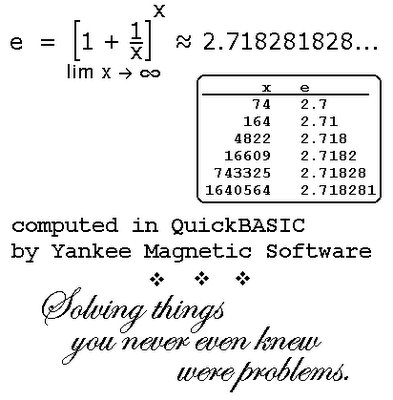e


One of Richard Feynman's human computers at Los Alamos was the Hungarian-American mathematician John Kemeny. After the war, Kemeny was teaching at Dartmouth College in New Hampshire when the first digital computers started to escape from the top-secret world of war and defense and onto universities and research.
In 1959 Kemeny and his colleague Tom Kurtz hatched a scheme to give access to and familiarity with these new machines to every Dartmouth student, and invented the programming language
B eginners
A ll-Purpose
S ymbolic
I nstruction
C ode
designed so that anyone could program a computer well enough to solve his/her computational problems with just one night of studying the language.
Later Kemeny became president of Dartmouth, and subsequently was the chairman of the US government's official inquiry into the Three Mile Island nuclear power plant accident. It's estimated that more lines of BASIC code reside in the world's computers than code in any other language.
Before Microsoft discontinued supporting it, QuickBASIC was Microsoft's dialect of BASIC. By the time of its demise around 1992, QB had become extremely powerful and sophisticated; there really isn't much that QuickBASIC can't do. If it does it a bit clumsily and a bit slowly, it does it, and it does it reliably. What were you going to do with those extra six seconds, anyway?
The previous post mentioned Feynman's hobby of opening top-secret Manhattan Project safes, and noting that many mathematicians and physicists chose 27 18 28 as their combinations, because these are the first six digits of the mathematical constant e, which every mathematician and physicist has memorized before even getting out of high school.
So much for e's approximate value (like pi, it never terminates into a perfect, exact value). Above is an equation which is one of several definitions of e, and also a method to compute the numerical value of e on a scientific calculator or by programming a computer. The bigger the
x = 1, 2, 3, 4, 5 ...
you plug into the equation, the more precise an e you get out the other end.
Much like pi, e pops up all over the place both in pure mathematics and in the actual behavior of The Real World, the Natural Universe.
In banking and finance, the "natural" behavior of compound interest -- a most unnatural thing, if you ask me -- centrally involves e.
e is in the equation for the catenary -- the shape a heavy dangling rope or chain (Latin: catena = chain) naturally takes, and thus the shape of the cables of large suspension bridges.
Mathematicians had recognized the unique, unusual, inherent and valuable virtues of e by 1600, and Napier's first scheme for logarithms used e as its base. (The more "practical" logarithms, called Common or Briggs, use base 10.)
Above, an equation in the Real World that involves e. Henri Becquerel first observed natural radioactivity in 1896, three centuries after the recognition of the purely mathematical virtues of e.
Feynman asked why the physical world bases its activities so fundamentally around mathematics. And then he replied that we just don't know why. It's very convenient, it's very assuring, it's very useful. It's also very beautiful and in many ways deeply mystical. But we don't have the slightest idea why Nature runs on mathematical principles.


0 Comments:
Post a Comment
<< Home